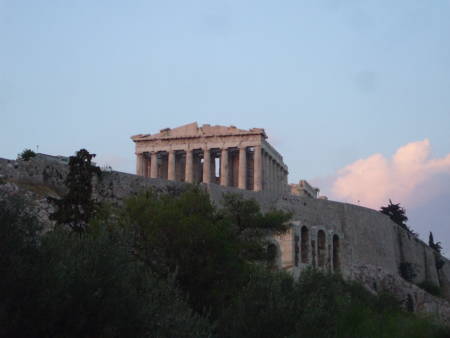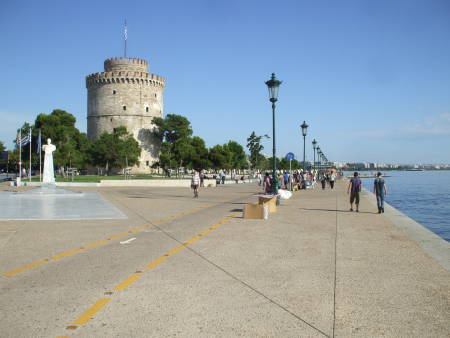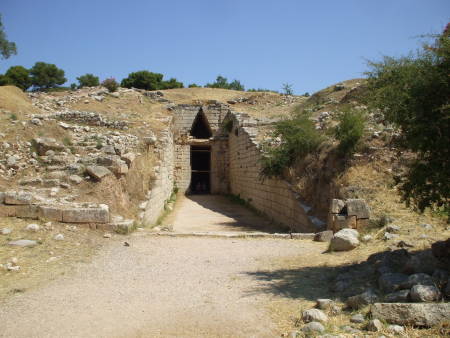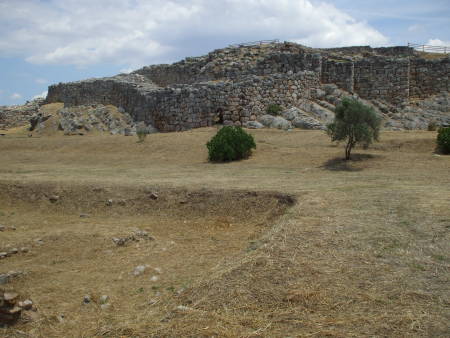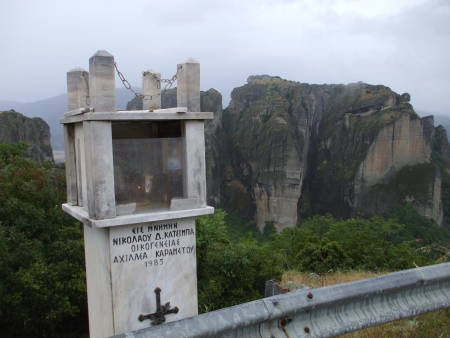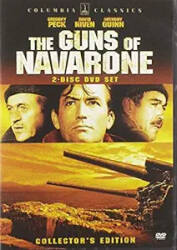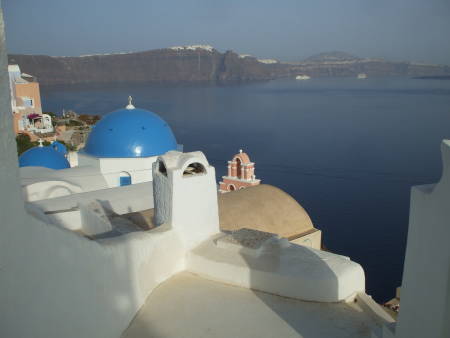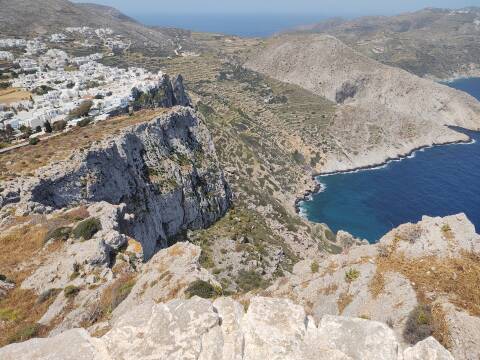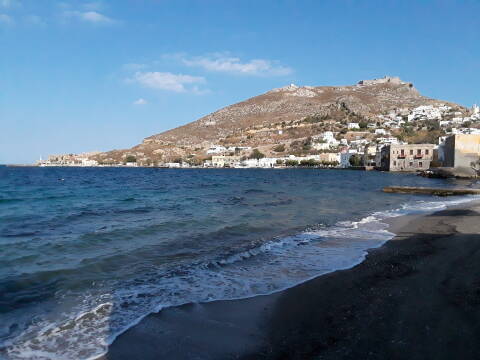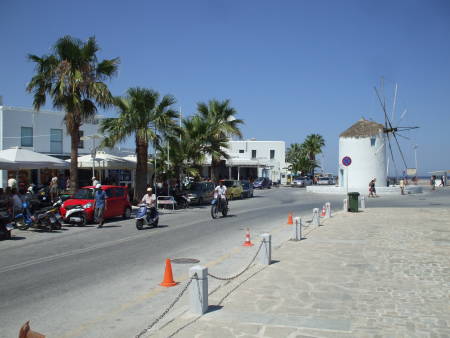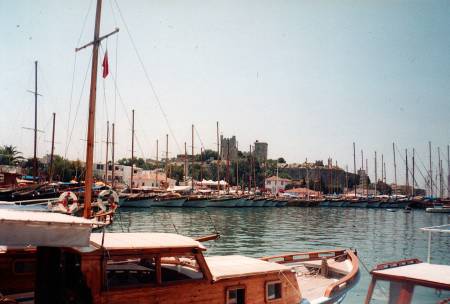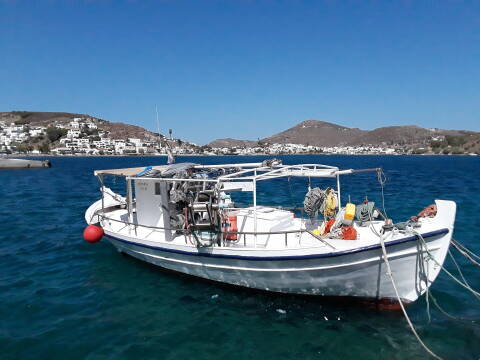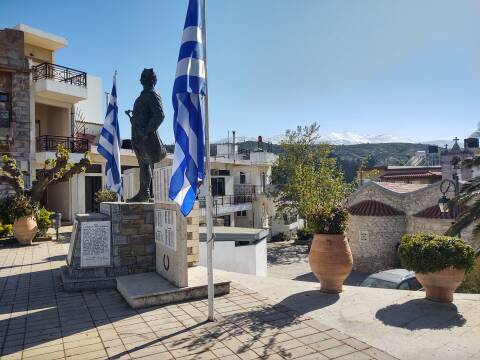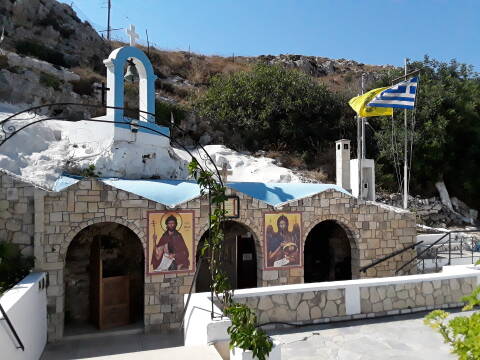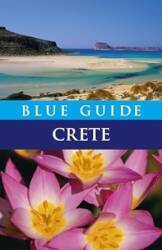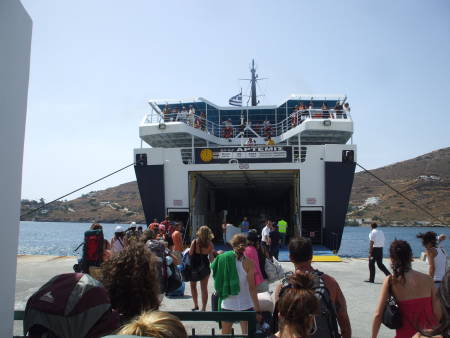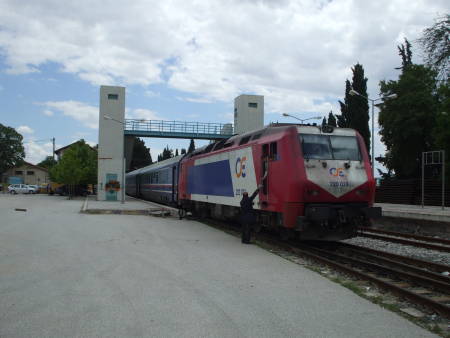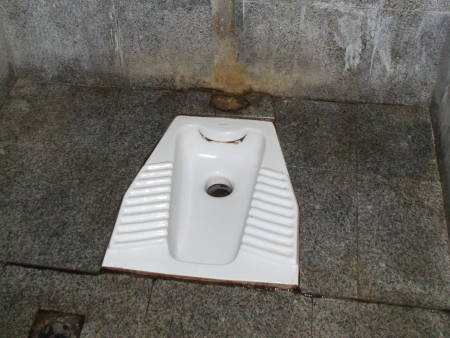
Travel in Greece
Athens and Cape Sounion
Athens / Αθήνα
All the travel marketing for Greece seems to show one of two things: The Parthenon, on the Acropolis in Athens, or the island of Santorini. Let's dive into the details of one of them right now, and then the Santorini pictures will appear on the page dedicated to that island. Athens is a great place to start a visit to Greece, although the city is certainly crowded and dirty and noisy. Start there and see the Acropolis complex, go down over the Areopagus hill to the agora and the forum, and wander through the nearby Plaka district. Then you will soon be ready to move on to the beautiful countryside or the islands.
One of the better pieces of advice I picked up along the way applies if you are flying into Athens, visiting the county, and then flying out of Athens at the end of your trip — Visit the National Archaeological Museum in Athens at both the beginning and end of a trip. The first visit will serve as a preview, the last may help you to organize and understand what you've seen and you will see items found at the place you have visited.


Here we see the Parthenon or Παρθενών, a temple to the goddess Athena Parthenos, or the Virgin Athena, one form of the patron of the city since some time before the temple's construction during 447-431 BC. The Parthenon replaced an older temple of Athena, which was built soon after the Battle of Marathon (about 490-488 BC) and then destroyed when the invading Persian army sacked the city in 480 BC.
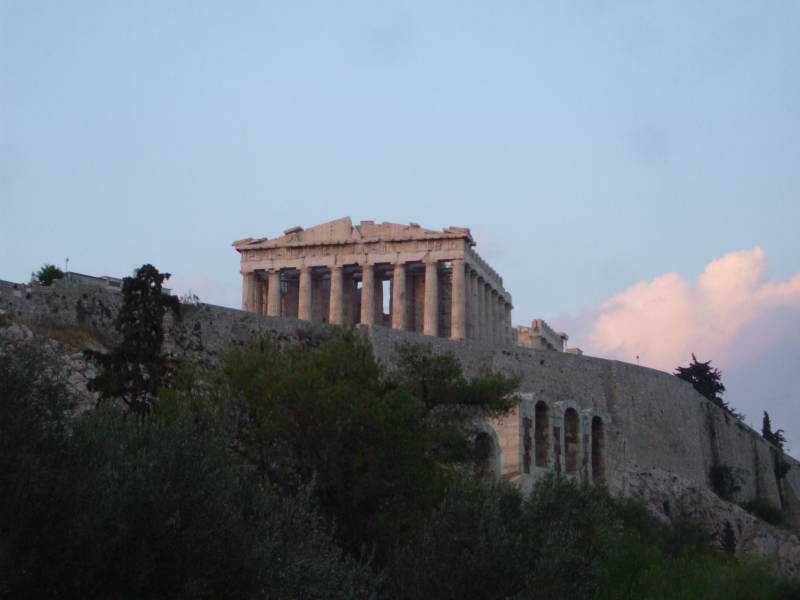
Sunset lights the Parthenon as seen from below the Acropolis.
While the Parthenon is a temple, at least as embodied by its architecture and setting, it was not really used as one. They was a small shrine on the site of an older sanctuary, and it probably was dedicated to Athena to provide a way of getting closer to the goddess, but the Parthenon never really hosted the cult of Athena Polias, the patron goddess of the city.
The temple's name comes from παρθενών (or parthenón), meaning the "unmarried women's apartments" in a house. This name seems to have originally referred only to one particular room within this temple.
The term παρθένος or parthénos could mean "maiden" or "girl", but it more significantly means "unmarried woman" and, especially, "virgin". See the term παρθενογένεση or parthenogenesis, meaning "birth to a virgin."

Yes, it's the Virgin Mother-Goddess, one of the world's recurring religious themes.
The Greeks applied the role of the virgin mother-goddess to Artemis, the goddess of wild animals, hunting and vegetation, and to Athena, the goddess of strategy and tactics, handicrafts, practical reason, and the patron goddess of the city of Athens.
During the century in which it was built, it was simply called ho naos or the temple. The first definite reference to it as Parthenon is in the 4th century BC.

Like most Greek temples, the Parthenon served as a treasury.
The Delian League had been formed in 478 BC to organize an alliance of 150 to 173 Greek city-states to fight against the invading army of the Persian Empire. The League was based on the holy island of Delos at the center of the Cyclades island group (metaphorically at its center although not really geographically so). It held its official meetings and kept its treasury in the Temple of Apollo on Delos.
With mainland Greece and the Ionian Greek cities of Asia Minor liberated from the Persians, the Spartans felt that the war was completed. The Spartan king Leotychides proposed evacuating all Greeks from the cities of Asia Minor to mainland Greece in order to permanently avoid their domination by the Persian Empire.

The Athenian Empire reached its height about 450 BC
Amazon
ASIN: B000V39KDO
Xanthippus, the commander of the Athenian forces, rejected this Spartan proposal. The Ionian Greek cities in Asia Minor were originally Athenian colonies, and Athens would protect them. The leadership of the Greek alliance shifted from Sparta and the Peloponnesian League to Athens.
A meeting was convened on Delos. It had an officially announced purpose, but the reality was that there were there main goals: prepare to repel a future invasion, exact revenge upon Persia, and divide the spoils of war. The member city-states could either provide armed forces or pay a tax into the League treasury. Most chose to pay the tax.
The League members also swore to share the same friends and enemies, and dropped iron ingots into the sea in ritual symbolism of this pledge. Sacrificing extremely valuable metal objects in bodies of water is another recurring theme.
Athens' power increased rapidly and Athens was soon using the League's navy for its own purposes. Pericles moved the Delian League's treasury from Delos to Athens in 454 BC. He announced that he did this to protect the treasury from seizure by Persian forces. But Plutarch reported that his rivals believed that Pericles was absconding with the wealth in order to fund elaborate building projects in Athens. This seemed like a reasonable conclusion at the time, given that Athens no longer accepted ships, weapons and men from the other League members and insisted that they just send money. It turned out to be true, as Pericles built the Parthenon on the Acropolis in Athens, the Temple of Poseidon at Cape Sounion, and many other non-defense expenditures.
Nearly 2500 years later we still have politicians appending pork-barrel projects to defense bills in order to enrich their home districts.
The Greeks finally defeated the Persians for the last time, with a treaty formalized in 450. War between the Athenians and the Peloponnesians soon broke out, with Greeks now fighting among themselves instead of fighting together against outsiders. The Peloponnesian War began in 431 BC, and the Athenian Empire and all traces of the Delian League dissolved with the end of that war in 404 BC.
Meanwhile the Parthenon had been constructed starting in 447 BC and finishing in 431 or possibly a little later for the final decorations.
It was considered at the time to be the finest example of a Doric order temple. It is renowned for a very subtle curvature of the stylobate or the platform on which the columns stand, the taper of the naos or inner temple walls, and the entasis or slight taper of the columns along with their slight lean inwards. Numerologists can marvel over:
- Its early name was the Hekatompedon or "Hundred-Footer".
- Their slight inward lean would make the columns meet almost exactly one modern mile above its center.
- The ratios of carefully chosen dimensions approximate the golden ratio.
Of course, if you measure enough dimensions and you are persistent enough with your multiplying, dividing, adding and subtracting, you can come up with any number you please. Pyramid fanatics are the real pros in this field.
Its real dimensions include a base of 69.5 by 30.9 meters (228.0 by 101.4 feet) with columns 1.9 meters (6.2 feet) in diameter and 10.4 meters (34.1 feet) tall.
That very subtle curvature of the base, intended to shed rainwater, makes the centers of the ends just 60 millimeters or 2.4 inches higher than the corners, and the centers of the sides 110 millimeters or 4.3 inches higher than the corners.

Its naos or inner sanctum held a statue of Athena Parthenos. It was what's termed a chryselephantine sculpture, made of plated ivory and gold panels on a wooden framework. This statue wasn't really the focus of religious attention. The cult image of Athena Polis, the patron of the city, was a olivewood xoanon figure periodically bathed in the sea and kept at an older altar along the north side of the Acropolis.
Pericles referred to the large statue in this structure as a gold reserve, saying that it contained forty talents of pure gold and all of it was removable.
The back room of the naos, the opisthodomus, stored the treasure collected from the Delian League members.
A large fire just after the middle of the third century AD destroyed the Parthenon's roof and much of the interior of the naos. It was repaired in the fourth century AD.
It then suffered the same fifth century fate as the Temple of Olympian Zeus.
The Byzantine Emperor Theodosius I had already shut down Delphi in 395. In 435 Theodosius II decreed that all pagan temples in the Byzantine Empire should be closed. The great cult image of Athena was taken to Constantinople some time later in the 400s. It was destroyed there, possibly during the siege of Constantinople in the Fourth Crusade in 1204.
The Parthenon was converted into the Church of the Parthenos Maria (that is, the Virgin Mary) in the 590s, with some reconstruction and rearrangement. It became the fourth most important Christian pilgrimage destination in the Eastern Empire after Constantinople, Ephesus, and Thessaloniki.
With the Fourth Crusade the city came under Italian control and it was converted to a Roman Catholic church.

The Ottoman Turks invaded Athens in 1456 and besieged the Florentine army defending the Acropolis until their surrender to the Turks in 1458.
The Turks may have returned the Parthenon to the Greek Orthodox Christians for their use, but by the end of the 1400s it had been converted into a mosque.
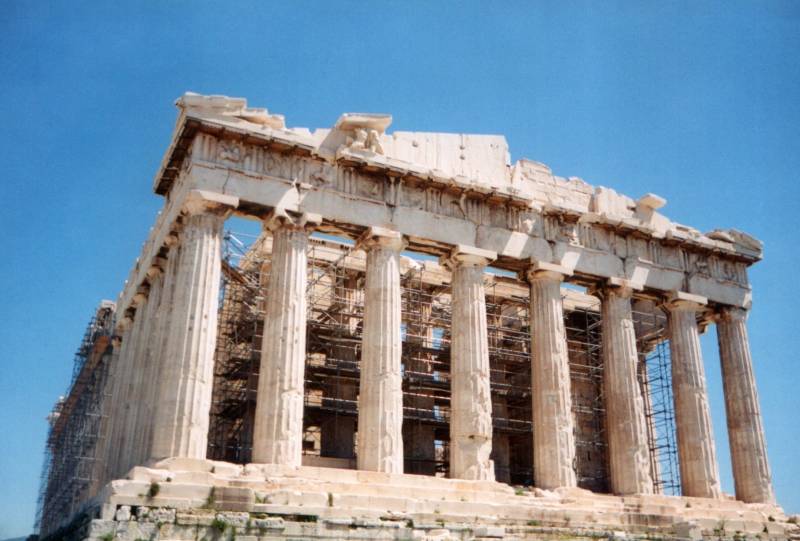
The worst of all its catastrophies happened on September 26, 1687.
The Venetians had sent an expedition commanded by Francesco Morosini to attack Athens and capture the Acropolis. The Ottomans Turks fortified the Acropolis, and used the Parthenon as both a gunpowder magazine and a refuge for the Turkish civilian community. The Turks figured that the Venetians would not aim their artillery at such a historic building.
That was, however, precisely what Morosini commanded his artillery to do. A Venetian shell struck the gunpowder magazine, killing about three hundred people and partly destroying the building. Morosini later tried to loot sculptures from the ruins and caused further damage.
The Venetians abandoned Athens a year later as a large Turkish force approached. They considered blowing up what remained of the Parthenon to prevent its use by the Turks, but at least they didn't do that.
The Erechtheion is a smaller temple on the north edge of the Acropolis. It was built in 421-406 BC. This was really the primary religious facility on the Acropolis.
It was dedicated to Athena Polis, the patron goddess and protector of the city, and to Poseidon Erechtheus. It was associated with the most ancient and sacred relics of Athens, including a xoanon (a wooden effigy not made by human hands, but which fell from the heavens) of Athena Polis, marks in the exposed stone made by a blow from Poseidon's trident and the resulting salt water well, and a sacred olive tree that grew from the mark made by Athena striking the exposed rock with her spear.
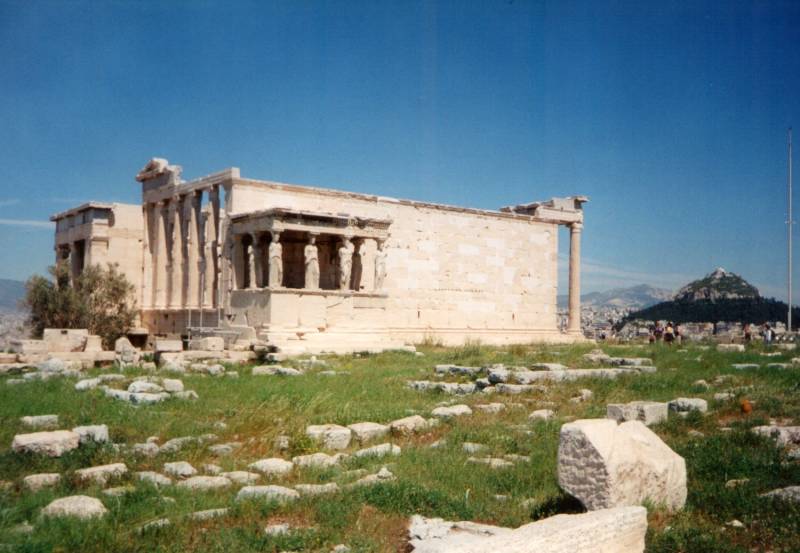
It also housed the supposed burial places of the mythical kings Cecrops and Erechthus. Erechthus was described in Homer's Iliad as a great king of Athens during the Archaic Period.

The sacred snake of the temple lived in its foundation. This snake represented the spirit of the mythical ancient king Cecrops. Its well-being was associated with the well-being of the city. The snake was fed honey-cakes by the Canephorae, the priestesses of Athena Polis. Once in the while the snake refused to eat the honey-cakes and this was thought to be a disastrous omen.
The root of the porch of the temple is supported by the famous Caryatid statues. At least more or less, anyway. A caryatid (καρυάτις if it's just one or καρυάτιδες if there are several) is a column or supporting pillar sculpted into a female figure.
Lord Elgin decided that one of the caryatids would look nice in his Scottish mansion. He removed one, and later sold it to the British Museum along with some sculptures from the Parthenon he had also taken (although over 50% of the Parthenon sculptures are in the Acropolis Museum),
He then tried to remove a second one, and when that wasn't going as well, tried to saw it into pieces. It was smashed, and its fragments later haphazardly reassembled with iron rods and cement.
Later attempts are restoration under the Greek government damaged the roof. The horrible air pollution in Athens caused more major damage.
The five remaining Caryatids were moved to the Acropolis Museum in 1979, what you see on the temple today are replicas.
Areopagus and the Agora
The Areopagus or Άρειος Πάγος is a large rock outcropping on the northwestern slope of the Acropolis. This "Rock of Ares" is where Ares was said to have been tried by the gods for the murder of Alirrothios, the son of Poseidon. In pre-classical times, before the 5th century BC, it was the meeting place of the city's council of elders.
The Agora of classical times is further down the slope. You can see the various large stoas, originally covered walkways or porticos lined with shops, including the restored Stoa of Attalos.
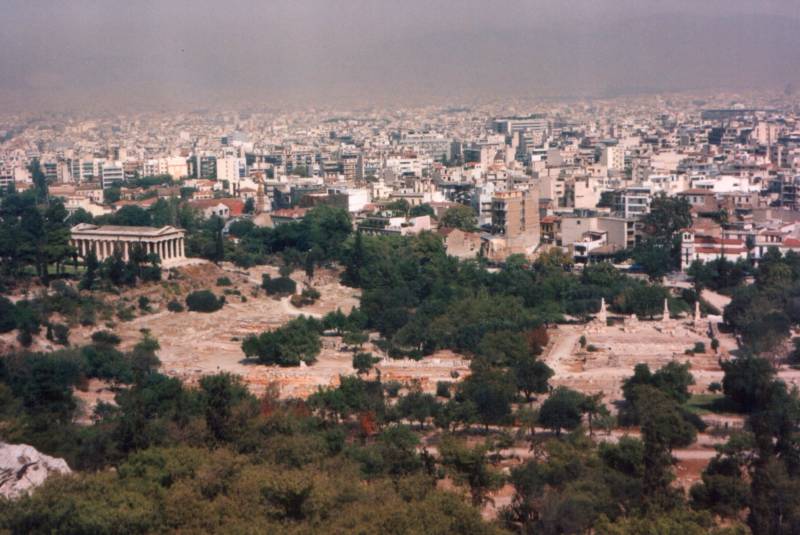
This stoa was originally built by King Attalos II of Pergamon, who ruled from 159 to 138 BC. He built it as a gift to the city of Athens in return for the education he had received there. At 115 meters long and 20 meters wide with two levels, it was larger than the other buildings of ancient Athens. There were two aisles and twenty-one rooms lining the western wall on each level.
The American School of Classical Studies at Athens fully reconstructed the Stoa of Attalos in 1952-1956, with funding from the Rockefeller family. It now houses the Museum of the Ancient Agora.

The Agora, whose name literally means that it's an open space, was laid out in the center of the city in the 6th or possibly 7th century BC. It was the center of political and public life in Athens, serving as the base for commercial, political, religious and military activity.
The Hephaisteion or the Temple of Hephaestus survives in very good condition. It is a Doric temple like the Parthenon but in far better shape. Its construction started in 449 BC, and it was consecrated in 416-415 BC.
Hephaestus was the patron god of metal working and craftsmanship, and there were many metal-working shops and potter's workshops immediately around the temple.
Just to the east of the Agora is the Roman era Forum and its prominent Tower of the Winds.
There are some great tavernas and sidewalk cafes near the Monastiraki metro station, some with views up to the Parthenon. All of them have views of the busy Athens street life.
An especially good one is Savvas or Σαββας, just off the Monostiraki Square toward Syntagma. Thanasis or Θανασις, facing it across the narrow alleyway, is almost as good. The cafes in that area have great food and drink at reasonable prices.

Monostiraki's night view of the Acropolis. Savvas and Thanasis are just off to your left.
Practical Matters
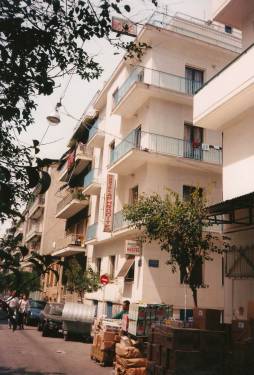
Aphrodite's House in Athens.
Aphrodite's House has beds in shared and private rooms
for not very much:
Aphrodite's House
12 Eynardou Street
(by the corner of 65 Mikhail Voda Street)
Athens, Greece
+30-88-10-589
+30-88-16-574 (fax)
hostelaphrodite.com
Take the metro to the Viktorias station. Cross the park, continue down the hill on the street that T's into the park. The second stoplight should be Mikhail Voda, turn right. Find the Atlantik grocery store at #65, Aphrodite's House is right behind it. On the other hand, if you're at the train station, you're within a few blocks. Walk east until you hit Mikhail Voda, then turn north (left).
Aphrodite's has a basement bar, but it's about twice the cost of sitting at a sidewalk cafe or taverna in the Plaka district at the base of the Acropolis!
I more recently stayed at the
Student and Travellers' Inn
in the Plaka district.
The location, atmosphere, and price are all great.
There are several tavernas in the square at the corner,
one is under the inn itself.
See the tables under the large awning toward the left
of this picture.
Student and Travellers' Inn
16 Kydathineon, Plaka,
+30-210-324-4808, +30-210-324-8802
fax +30-210-321-0065
studenttravellersinn.com/
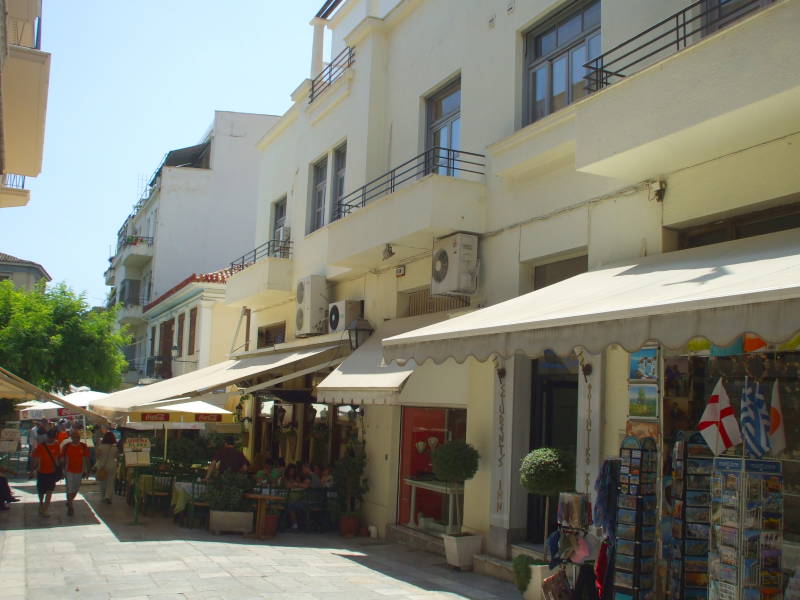
The entry to the Student and Travellers' Inn is the first door here, between the nearest awning and the air conditioner.

Climb up Philopappos Hill some evening to watch the sun set. Above is what you see looking back toward the Acropolis from Philopappos Hill at sunset. The large conical hill in the distance to the right of the Parthenon is Lykabettos or Lykavittos. The local legend is that it was inhabited by wolves, hence its name as "the hill walked by wolves."
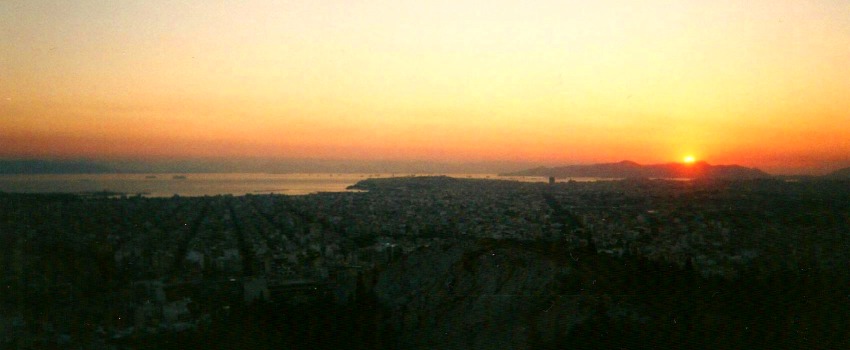
Above is the view of the sunset beyond Athens' port of Piraeus. That's where you board the ferries for the islands.
Check ferry schedules and buy tickets:
Easter in Athens
The Church of Saint Panteleimon of Acharnai is the largest church in Athens and one of the largest in all of Greece. It was built much more recently than many Athens landmarks. Its foundations were laid out in 1910 and it was consecrated in 1930. It's just off Acharnon Avenue.
Easter or Πάσχα is the biggest holiday in the Orthodox Christian world. The main event is the service on Μεγάλο Σάββατο, Megalo Savvato or Big Saturday, starting at 2300 and marking the arrival of Easter at midnight. There may be earlier services, at 1700 and 1900 at this church the time I was there on Easter, but the late night one is the big service of the year.
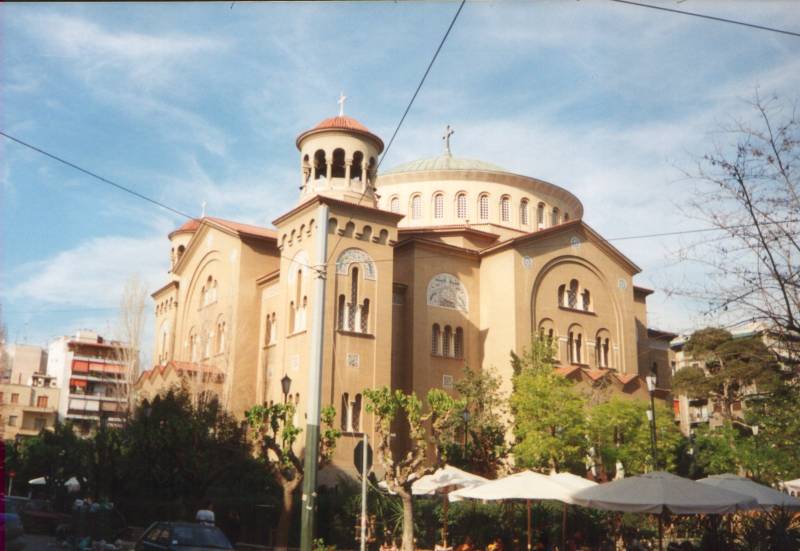
This girl is selling candles across the street from the church. Those are large beeswax candles and colored plastic cups with holes in their bottom. You slide the candle through that cup, so the flame is sheltered from wind and the cups catches the molten beeswax.

However, you just buy the candle and holder and take it with you unlit. Don't light it, lighting the candles is a big step in the service.
The church is dedicated to Άγιος Παντελεήμων Αχαρνών or Saint Panteleimon of Acharnai, a man who was martyred in Nicomedia in Bithynia during the persecution of Christians under the Emperor Diocletian in 303 AD. Evidence exists suggesting that a man named Pantaleon died as a Christian martyr in that time and place, but some consider the stories of his life and death to be partly or even purely legendary.
He was said to have been the son of a rich pagan, instructed in Christianity by his mother, Saint Eubula. She died and he drifted away from Christianity. He studied medicine under the renowned physician Euphrosinos, and under his patronage he became physician to the Emperor Maximian or Galerius.
Saint Hermolaus, bishop of the church at Nicomedia according to the later writings, won him back to Christianity by convincing him that Christ was the ultimate physician. Unfortunately, the example of Pantaleon led to European medicine up to the 16th century largely assuming that reliance on faith takes precedence over medical science.
Pantaleon converted his father by miraculously restoring a blind man's sight by invoking the name of Jesus. The wealthy father subsequently died, leaving Pantaleon wealthy and envied by his colleagues. They denounced him to the Emperor.
Diocletian wanted to save his favorite physician and gave him a change to renounce his faith. Pantaleon openly confessed his faith and then miraculously healed a paralyzed man. Diocletian took this as a demonstration of magic and condemned him to death.
This is where the martyrologies really kick into gear. Pantaleon's flesh was burned with torches, but Christ appeared in the form of Bishop Hermolaus to heal and strengthen Pantaleon as the torches suddenly extinguished.
A cauldron of molten lead was prepared. But when Pantaleon and the apparition of Christ stepped into it, the fire went out and they stepped out before the lead solidified and became cold.
Fire wasn't working, so they tied Pantaleon to a large stone and threw him into the sea. The stone floated.
Next they threw him to some wild beasts, who turned out to not be vicious at all. They fawned upon him and generally got in the way and refused to leave him until he blessed them all.
Then they tied him to a wheel for torture, but the ropes snapped and the wheel broke.
Finally they tried to behead him, but the sword was bent by his unharmed neck and the executioners were converted to Christianity.
Pantaleon asked that they all be forgiven, which led to his being named Pantaleon Panteleimon (meaning "all-compassionate" or "all-forgiving"). Then he announced that it was now possible to behead him, so they did, and a mix of blood and a white milk-like liquid poured out.
A vial of this liquid was taken to Napoli or Naples. Saint Alphonsus wrote: "At Ravello, a city in the kingdom of Naples, there is a vial of his blood, which becomes blood every year [on his feast day], and may be seen in this state interspersed with the milk as I, the author of this work, have seen it."
This is in the nearby town of Ravello, and not in Napoli itself where the Duomo or main cathedral has other vials of miraculously de-coagulating blood. The Capella di San Gennaro (or Januarius) is in honor of a saint martyred in 305 at Pozzuoli, west of Napoli. His skull and two phials of his blood are in the most elaborate chapel, the next chapel to the east has assorted other bones. The blood now miraculously de-coagulates three times a year, all the better for organizing multiple festivals: the first Sunday in May, 19 September, and 16 December.
Panteleimon would be pleased to see the crowd in the church late on Big Saturday evening. It was packed when I was there.
The interior is mostly one large open naos or nave, a rounded center space under the main rotunda with four stubby arms. The arm at the front is blocked by the iconostasis, a wall dividing the nave from the altar area. A doorway at the center leads to the altar area.
An iconostasis is built and decorated according to a a very specific design. We use the word iconic to mean that something communicates some meaning through a standardized or expected appearance. Icons and iconostases are not the place for artistic experimentation or wacky improvisation, they carefully follow specific and detailed designs.
The row of icons about eye level to either side of the central doorway is called the worship row, with special significance for the two immediately beside the doorway. The icon to the right of the central door shows the saint or event to which the church is dedicated. The icon to the left typically shows the Παναγία or Panagia, a specific pose of Mary with the infant Jesus.
A large church like this one will also have icons on the doors, typically showing the Annunciation at the top and the four gospel writers below.
The Communion of the Apostles appears above the central door.
Then, at least in larger churches like this one, there may be four rows of icons spanning the entire iconostasis above the doors. The first row is the Δέησης or Deësis (or prayer or supplication) row, with the Christ in Majesty or Χριστός Παντοκράτωρ or Christos Pantocrator at the center. He is flanked by the Virgin Mary and John the Baptist, with archangels Michael and Gabriel flanking them, and other saints spreading to either side.
The second row up would show the great liturgical feasts, twelve or so depending on the size of the iconostasis.
The third row up would show the Virgin of the Sign (Mary with both hands raised in prayer, with a circle on her breast showing Jesus with his right hand raised in blessing) at the center, with Old Testament prophets extending out on either side.
The top row would show the icon of the Hospitality of Abraham (the three angels who visited Abraham at Mamre, sometimes called the Old Testament Trinity) with the Old Testament patriarchs from Adam to Moses on either side.
As in a Russian Orthodox service, there are very few seats as everyone physically able stands. As the service neared the one-hour mark and midnight, they turned out the overhead electrical lights and then began extinguishing all candles except the small ones in red glass bowls hanging before the icons. The priests had gone to the altar area behind the iconostasis, and now closed the door. Five priests in front of the iconostasis continued to sing or chant as they had through the entire service.
The darkened church represents Christ's passage through the underworld, and the restoration of light represents his triumph over death. The lights were all out long enough for your eyes to adjust to the very low light provided by the few remaining candles, so it was very noticeable when it appeared that people with torches were moving around behind the iconostasis.
The doors were thrown open and a priest came out with what looked like two torches. Each was a bundle of twenty or more candles bundled together, with a flame maybe a foot long coming off of it.
He called out, Χριστός ανέστη!, Khristos aneste! or Christ is risen! The congregation then starts to take a more active part in the service, responding to the priest. The priest starts passing the candle flame out, and it makes its way out through the congregation. With people packed in about as close as they can stand, there are enough large lighted candles that the air really ripples with heated air currents as you look across the church.
There were lots of fireworks going off as we left, everyone walking down the streets with lighted candles. When I returned to Aphrodite's House, the guy at the desk said, "Oh, you're blessing the pension!" He gave a disclaimer of "Now I'm not very religious, but...", and went on to explain that taking the lighted candles down the streets blessed the streets, and if you stopped to visit someone, you blessed their place. Most everyone stays up late on that Saturday, and many people visit friends or family after midnight.
The western and eastern churches use a similar algorithm to specify the date for Easter, but the western church bases it on the Gregorian Calendar (as in Pope Gregory) while the eastern church bases it on the Julian Calendar.
|
Dates for Easter (Gregorian calendar) |
||
| Year | Western | Eastern |
| 2019 | April 21 | April 28 |
| 2020 | April 12 | April 19 |
| 2021 | April 4 | May 2 |
| 2022 | April 17 | April 24 |
| 2023 | April 9 | April 16 |
| 2024 | March 31 | May 5 |
| 2025 | April 20 | |
After the First Council of Nicaea in 325 AD, the date calculation for Easter was completely disconnected from the Jewish calendar and its calculation for Passover (beginning on the 15th day of the month of Nisan). Easter was defined as the first Sunday after the full moon following the March equinox. The equinox was defined as the 21st day of March, even though it occurs on the 20th in most years if you're being strict about the astronomy. Similarly, the church's definition of a full moon is sometimes off by a day from the strict astronomical measurement.
All of this gets messy because the lengths of the day, month and year bear no integer relationships to each other.
It's messier yet because the eastern churches reckon March 21st by the Julian calendar instead of the Gregorian one, even though the Gregorian calendar is in practical use.
The result is that in some years the two Easters are on the same day, but in other years they are 1, 4 or 5 weeks apart.
Cape Sounion / Ακρωτήριο Σούνιο
Take a day trip out of Athens to Cape Sounion. You can take a bus, I think they still leave from near the Viktorias metro station.
Go out to Cape Sounion in the afternoon, and if possible, hang around until sunset.
The Temple of Poseidon appropriately overlooks the sea, with views to the nearby islets of Makronisi and Patrolou. More distant islands of Kea, Kithnos, and Serifos can be seen, and on especially clear days, even Milos, some 97 km away.
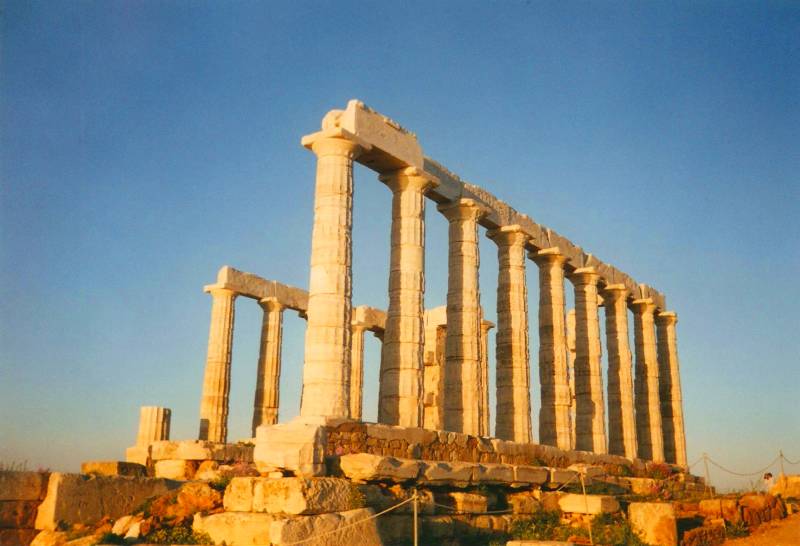
Greek temples are situated in significant locations. The ancient Greeks did not simply look for cheap real estate, they built their temples in locations so that the physical setting itself was at least as much a part of the religious experience as the structure itself.
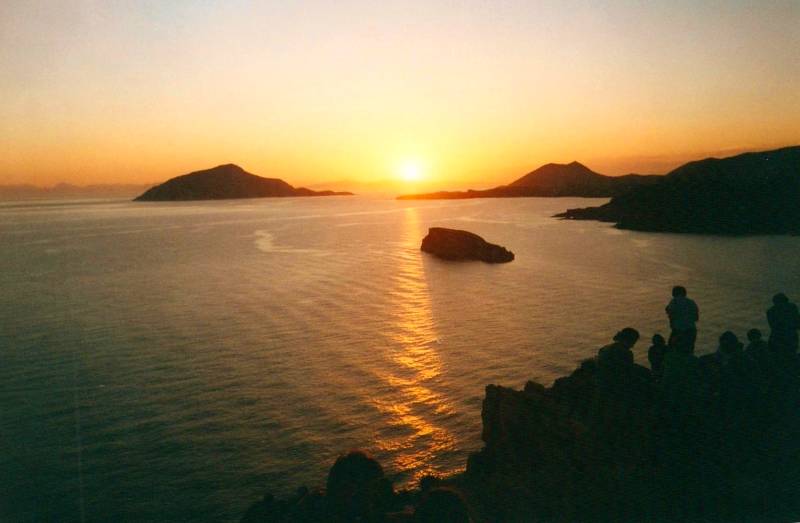
The sun sets behind the center of the caldera of the extinct volcanic island of Patroklou at the equinoxes, suggesting some astronomical significance for the temple's precise location.
Poseidon was second only to Zeus in power, manifesting his rage in the form of powerful storms. Ancient Greek religion was fundamentally propitiatory, requiring that one constantly seek the favor of relevant gods by prayers, sacrifices and gifts in order to avoid misfortune. Mariners and even entire city-states could propitiate Poseidon by making animal sacrifices and leaving offerings at this temple.
Homer mentioned the cape in the Odyssey, saying that the helmsman of the ship of King Menelaos of Sparta died at his post while rounding "holy Sounion, cape of Athens". Menelaos then landed at Sounion to give his companion the full funeral honors of cremation on a funeral pyre.
Legend says that this is the point where Aegeus, the king of Athens, jumped off the cliff to his death, giving his name to the Aegean Sea. His son Theseus had gone to Crete to fight the Minotaur, promising to return using a white sail on his boat if he had survived the battle.
Theseus killed the Minotaur but forgot to change sails. Aegeus recognized his ship, saw the black sail, and jumped.
The original Temple of Poseidon was built of tufa in the Archaic Period, and was probably destroyed in 480 BC by Persian troops during Shahanshah Xerxes I's invasion of Greece in the second Greek-Persian War.
The ruined temple seen today was built in about 440 BC, during the rule of the Athenian Pericles who also rebuilt the Parthenon in Athens and generally never met a public works program he didn't like.
It's a typical hexastyle temple, with six columns of locally quarried white marble on its front portico. There were 42 columns around its four sides originally, 15 still stand today.
The ναός or naos would have been a windowless rectangular room at its center. This would have contained the cult image, a bronze statue of Poseidon standing about as tall as the ceiling, or about six meters tall. The National Archaeological Museum in Athens has an example of this type of statue. It's very dramatic despite being just over a third the height of the one that would have been in this temple's naos.

The blue circled dot indicates a non-directional navigational beacon. The temple is on the point of land marked as Ákra Soúnion.
It's a pleasant and scenic bus ride down the coast road from Athens, and Sounion makes for a very nice day trip.
But be careful — make sure that you know when the last bus leaves for Athens, and make sure that you are on it! Otherwise you will be like a Spartan baby, left to fend for yourself overnight in the open.
Travel Through Greece

Athens has some nice things to see, but you will want to leave for the beautiful countryside or the islands.

Find that train station or one of the two main bus stations and start traveling around Greece!
This page is also part of the Athens to Paris by Train series. Start at the beginning of that series to get the background and the details so far.
International travel
